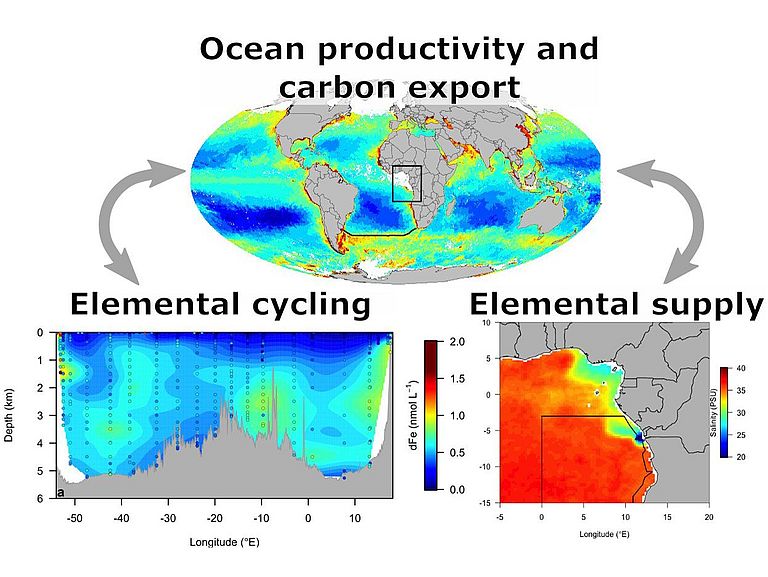ElbeXtreme
Monitoring and modelling of extreme events in the Elbe estuary and the German Bight
EMS-FORE
Eastern Mediterranean Sea as a model for Future Ocean Research
CDRmare AIMS³
Alternate scenarios, Innovative technologies, and Monitoring approaches for Sub-Seabed Storage of carbon dioxide
Ocean Glow
Controls on ocean productivity using ocean fluorescence detected from space
ReSEAt
Drivers of nutrient limitation and carbon export in the South East Atlantic
AMMOTRACe
Marine AMMunitiOn dump site exploration by surface- and underwater-based laser mass spectrometric TRACing technology
DAM CONMAR
CONcepts for conventional MArine Munition Remediation in the German North and Baltic Sea
NeuroMetalle
Element and Isotope Signatures in Neurodegenerative Diseases
LABPLAS
Understanding the sources, transport, distribution and impacts of plastic pollution
P-LEACH
Plastic-LEACHate impact on ecosystem functions and human health
GEOTRACES Abschnitt-Expeditionen
Prof. Achterberg's working group has participated in a large number of GEOTRACES research cruises to date (current example: SO308)
Biogeochemie der wichtigsten Elemente im Atlantik und im Pazifischen Ozean
MOSES
Modular Observation Solutions for Earth Systems
REEBUS
Role of Eddies in the Carbon Pump of Eastern Boundary Upwelling Systems
C-SCOPE
Towards Marine Carbon Observations 2.0: Socializing, COnnecting, Perfecting and Expanding
EA-RISE
Euro-Argo Research Infrastructure Sustainability and Enhancement
COMFORT
Our Common Future Ocean in the Earth System
WASCAL
West African Science Service Centre on Climate Change and Adapted Land Use
SOOP
Building an innovation platform for more ocean observation and technologies where new hardware and software will be used to collect oceanographic and climate-related data.
Sailing for Oxygen
A citizen science project initiated to help marine researchers measure important information in the Kiel and thereby better understand the distribution of oxygen, temperature and salinity.
TreX
The project investigates deep water inflow spreading rates and mixing in the Gulf of St. Lawrence, involving the release of an inert tracer (SF5CF3) in October 2021 and subsequent campaigns in 2022 to measure and examine tracer concentrations, alongside studying ventilation using anthropogenic tracers CFC-12 and SF6.
ShipTRASE
investigating the influence of gas and liquid ship emissions on trace gas cycling in the surface ocean
Regional focus on the Indian Ocean
investigating this region as a potential emissions hotspot for many atmospherically important trace gases, such as DMS, and determining the influence of anthropogenic deposition on surface ocean cycling of trace gases
COS
A novel approach to quantify global ocean emissions of carbonyl sulfide
BELS
Bubble exchange in the Labrador Sea
BASS
Biogeochemcial processes and air-sea exchange in the sea-surface microlayer
ICEBERG
Innovative community engagement for building effective resilience and Arctic Ocean pollution-control governance in the context of climate change
MUSE
CO2 eddy covariance buoy development
FS SONNE SO305 - BIOCAT
Biogeochemische/Atmosphären Prozesse im Golf von Bengalen: Ein Beitrag zur ‚2nd International Indian Ocean Expedition‘, BIOCAT-IIOE2, Colombo/Sri Lanka- Singapur,10.04.-22.05.2024
CONNECT (BMBF - Federal Ministry of Education and Research)
Pan Atlantic connectivity of marine biogeochemical and ecological processes and the impact of anthropogenic pressures
RV SONNE SO287 - CONNECT
Pan Atlantic connectivity of marine biogeochemical and ecological processes and the impact of anthropogenic pressures, Las Palmas/Canary Islands-Guayaquil/ Ecuador: 11.12.-2021-11.01.2022
RV Poseidon 533/1: AIMAC
Atmosphere–ocean–island-biogeochemical interactions in the Macaronesian Archipelagos, Mindelo/ Cape Verde-Las Palmas/Canary Islands: 28.02.-22.03.2019
Boknis Eck Time-Series Station
Eckernförde Bay, SW Baltic Sea
MEMENTO
The MarinE MethanE and NiTrous Oxide database
NITROSO
Nitrous oxide in the Southern Ocean, Sino-German project funded by SOA and BMBF
BONUS INTEGRAL
Integrated carbon and trace gas monitoring in the Baltic Sea, funded by EU and BMBF
PETRA
Pathways and emissions of cliamte-relevant trace gases in achanging Arctic Ocean, UK-German project funded by NERC and BMBF
Nitric oxide
NO in the Ocean, funded by DAAD
Carbon monoxide
CO in the coastal ocean, funded by CSC
Measurements of isotopic signatures and short-lived tracers of nitrogen cycle processes in the Baltic Sea
funded by Alexander von Humboldt Foundation



